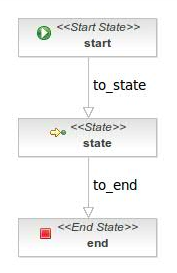Process modelling
We are going to describe the elements which define a jBPM process. A process is composed by:
- Nodes
- Transitions
To create a process definition in a graphical way, you can use jBPM Graphical Process Designer. This tool is packaged as a Eclipse plugin.
Nodes
The define the states of the process definition. They are connected by transitions. Both define the different path which can be followed in a running process definition. A running process definition is called process instance.
There are several types of nodes:
Start node
End node
End nodes define the end of the process execution. A process may have several end nodes. In this case the process finish when the process arrives to any of these end nodes.
Task node
Node node
State node
Decision node
You can define the behaviour using a Action element, which will be executed when the process arrives to the node.
Fork node
A fork node splits one path of execution into multiple concurrent paths of execution.

